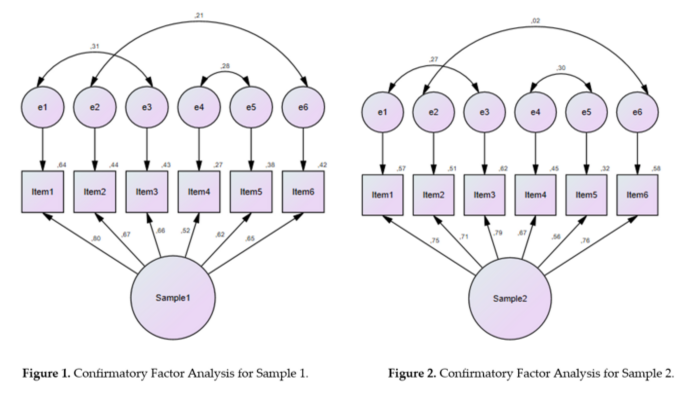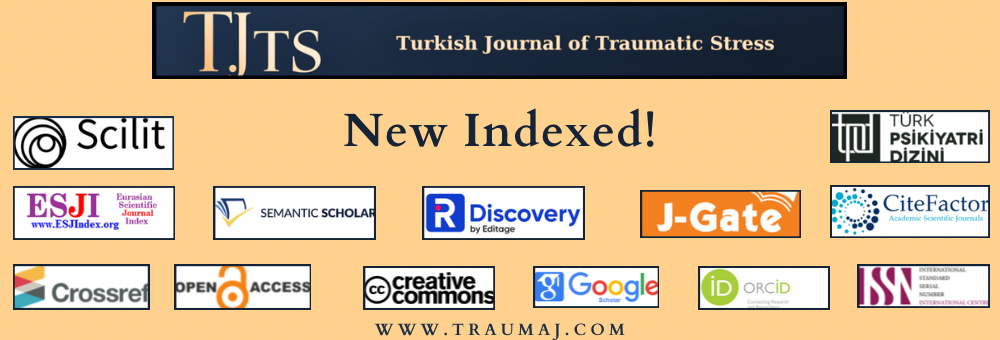Psychometric Properties of the Turkish Version of the Impact of Event Scale – 6
Psychometric Properties of the Turkish Version of the IES – 6
DOI:
https://doi.org/10.63175/tjts.6Keywords:
earthquakes, psychometrics, post-traumatic stress disorder, Impact of Event Scale, short versionAbstract
Background: Natural disasters, such as the earthquake that occurred in Turkey on February 6, 2023, can lead to significant psychological distress, including post-traumatic stress disorder (PTSD). The Impact of Event Scale – 6 (IES-6), a short version of the revised Impact of Event Scale (IES-R), is a tool that has been validated in various populations for assessing PTSD symptoms following traumatic events. This study aims to evaluate the psychometric properties of the Turkish version of the IES-6 following the Kahramanmaraş earthquake.
Methods: A cross-sectional study was conducted with 220 earthquake survivors and 220 controls. Data were collected using a sociodemographic questionnaire and the IES-6 scale. Reliability was assessed using Cronbach's alpha coefficient, while validity was evaluated through exploratory and confirmatory factor analyses. Participants' responses were analyzed to assess the scale’s internal consistency and factor structure.
Results: Exploratory factor analysis revealed that the Turkish IES-6 exhibited a unidimensional structure in both groups. Confirmatory factor analysis, after adjusting for error covariances, confirmed that the one-factor model had acceptable fit indices. The obtained Cronbach’s alpha value indicated strong internal consistency. The total scores of the scale showed a high correlation between the groups (r = 0.90, p < .001).
Conclusion: The Turkish version of the IES-6 demonstrates strong psychometric properties, including valid factor structure and high reliability, making it an effective tool for assessing PTSD symptoms in populations affected by natural disasters. Future longitudinal studies examining the long-term psychological effects of trauma could contribute to a better understanding of trauma’s impacts.
References
References
1. Kurhan F, Kamış GZ, Dinç D, et al. Van çığ afetinden kurtulan kişilerde travma sonrası stres bozukluğu sıklığı ve ilişkili faktörler: 6 aylık izlem çalışması. Turk Psikiyatri Dergisi. 2024;35(3):178-185.
2. Goldmann E, Galea S. Mental health consequences of disasters. Annu Rev Public Health. 2014;35(1):169-183.
3. Türkiye earthquake situation report #6. UNFPA Türkiye, 2023. https://turkiye.unfpa.org/en/turkiye-earthquake-situation-report-no-6. Accessed December 12, 2024..
4. Uğur M, Kartal F, Mete B, Tamam L, Demirkol ME. Deprem onrası akut stres bozukluğu olanlarda travma esnasındaki çözülmenin, anksiyete düzeyi, algılanan stres, anksiyete duyarlılığı ve deprem stresiyle baş etme ile ilişkisi. Türk Psikiyatri Dergisi. 2021;32(4):253-260.
5. Sayed S, Iacoviello BM, Charney DS. Risk Factors for the Development of Psychopathology Following Trauma. Curr Psychiatry Rep. 2015;17(10):80.
6. Foa EB, McLean CP, Zang Y, et al. Psychometric properties of the Posttraumatic Diagnostic Scale for DSM–5 (PDS–5). Psychol Assess. 2016;28(10):1166-1171..
7. Blevins CA, Weathers FW, Davis MT, Witte TK, Domino JL. The posttraumatic stress disorder checklist for DSM‐5 (PCL‐5): Development and initial psychometric evaluation. J Trauma Stress. 2015;28(6):489-498.
8. Weathers FW, Bovin MJ, Lee DJ, et al. The Clinician-Administered PTSD Scale for DSM–5 (CAPS-5): Development and initial psychometric evaluation in military veterans. Psychol Assess. 2018;30(3):383-395.
9. Cloitre M, Shevlin M, Brewin CR, et al. The International Trauma Questionnaire: Development of a self‐report measure of ICD‐11 PTSD and complex PTSD. Acta Psychiatr Scand. 2018;138(6):536-546.
10. Davey C, Heard R, Lennings C. Development of the Arabic versions of the impact of events Scale‐Revised and the posttraumatic growth inventory to assess trauma and growth in middle Eastern refugees in Australia. Clinical Psychologist. 2015;19(3):131-139.
11. Sveen J, Low A, Dyster-Aas J, Ekselius L, Willebrand M, Gerdin B. Validation of a Swedish version of the Impact of Event Scale-Revised (IES-R) in patients with burns. J Anxiety Disord. 2010;24(6):618-622.
12. Soroush A, Ziapour A, Abbas J, et al. Effects of group logotherapy training on self-esteem, communication skills, and impact of event scale-revised (IES-R) in older adults. Ageing Int. 2022;47(4):758-778.
13. Okanoya J, Kimura R, Mori M, et al. Psychoeducational intervention to prevent critical incident stress among disaster volunteers. Kitasato Medical Journal. 2015;45:62-68.
14. Thoresen S, Tambs K, Hussain A, Heir T, Johansen VA, Bisson JI. Brief measure of posttraumatic stress reactions: Impact of Event Scale-6. Soc Psychiatry Psychiatr Epidemiol. 2010;45(3):405-412.
15. Jeong J, Kim AR, Hilton C, Hong I. Impact of Event Scale-6 (IES-6) for US adults who experienced the COVID-19 pandemic. BMC Psychiatry. 2022;22(1):490.
16. Horowitz M, Wilner N, Alvarez W. Impact of Event Scale: A measure of subjective stress. Psychosom Med. 1979;41(3):209-218.
17. Weiss D, Marmar C. The impact of event scale-revised. In: Wilson J, Keane T, eds. Assessing Psychological Trauma and PTSD. Guilford Press; 1997:399-411.
18. Kaiser HF. An index of factorial simplicity. Psychometrika. 1974;39(1):31-36.
19. Schumacker RE, Lomax RG. A Beginner’s Guide to Structural Equation Modeling. psychology press; 2004.
20. Büyüköztürk Ş, Çokluk-Bökeoğlu Ö, Köklü N. Sosyal Bilimler İçin İstatistik. 7th ed. Pegem Akademi Yayıncılık; 2011.
21. Giorgi G, Fiz Perez FS, Castiello D’Antonio A, et al. Psychometric properties of the Impact of Event Scale-6 in a sample of victims of bank robbery. Psychol Res Behav Manag. Published online 2015:99-104.
22. Hosey MM, Leoutsakos JMS, Li X, et al. Screening for posttraumatic stress disorder in ARDS survivors: validation

Downloads
Published
How to Cite
Issue
Section
License
Copyright (c) 2025 Cansu Ünsal, Büşra Kök, Bülent Aykutoğlu

This work is licensed under a Creative Commons Attribution 4.0 International License.







